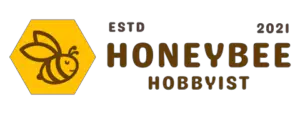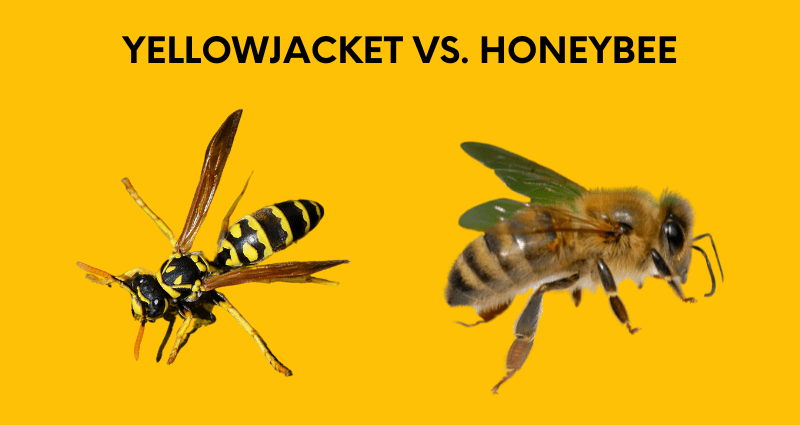Honey bees are essential crop pollinators, and the FDA estimates that around $15 billion of added value is created through bee pollination of crops. Meanwhile, yellow jackets are wasps. While they are also pollinators, they can eat pests and are considered carnivore scavengers.
What are Yellow Jackets?
Yellow jackets are a member of the Vespidae family, comprised of wasps and hornets. There are nearly 5,000 species in this family.
Much like honey bees, they are social, living in colonies consisting of a queen and mostly female workers.
They build nests out of plant fibers which they’ve chewed to form a paper-like substance. They choose nest sites in underground voids, holes, or high, sheltered areas like house eaves or attics. You may also find them in trees, shrubs, or a wall cavity around buildings.
In terms of appearance, they have bright yellow and black stripes on their bodies, though they are usually brighter than honey bees and have a narrower waists.
Generally, yellow jackets will live for only a year, producing new queens and male drones at the end of the summer. They mate, and the queen overwinters while the rest of the colony dies.
What are Honey Bees?
honey bees are a member of the Apidae family and native to Africa and Eurasia.
They’re social insects, known for having large colonies with a queen bee and worker bees living in a large wax hive above ground. However, bees are also happy to live in constructed, manmade hives.
They’re also yellow and black but are generally a little duller in color and rounder. Their bodies are covered in fine fuzz that helps them collect pollen.
Honey bees produce and store honey, which is what drove humans to keep bees — likely since prehistoric times. However, beeswax can also be used to make various products, including soap, candles, lip balms, and cosmetics.
Honey bees have various lifespans depending on their role. While the queen can live for two or more years, the workers will only live between 15–200 days, which is seasonally dependent. The drones live for roughly 55 days.
Yellow Jackets vs. Honey Bees: What Are Their Differences?
While yellow jackets and honey bees may seem similar in a lot of ways, they are fundamentally different from one another.
| Characteristics | Honey Bees | Yellow Jackets |
| Taxonomy | Honeybees are from the Apidae family, belonging to the Apini tribe of the genus Apis. | Yellow jackets are from the Vespidae family of the genus Vespula. |
| Physical Appearance | While they are both yellow and black, honey bees have a slightly duller yellow that is closer to amber. Their bodies are also small, round, and covered in fuzz. Their wings and hind legs are broader and flatter, as this helps them to carry pollen. Their legs even have little pockets to assist in the task! The heads of honey bees are topped with two antennae with little bends in the middle. Click here to review honeybee anatomy. | Yellow jackets have a much brighter yellow color, tend to be more slender, and have a thin waist (often pinched between the thorax and abdomen). They have smoother bodies as they don’t carry as much pollen as honey bees. Their wings tend to be narrower, with white or yellow faces. Unlike honey bees, their heads are topped with two straight antennae. |
| Nest | Honeybees use wax to create the hexagonal honeycomb cells that make up their bee nests, often building them above ground in hollow trees or sheltered areas. They are equally happy to use artificial honey bee hives provided by beekeepers in an apiary (a location where constructed bee hives are kept). They reuse their hives and build on to them as their colonies grow. If the hive becomes too crowded, half the bees in the colony will leave to start a new one (known as swarming). | Yellow jackets build wasp nests underground and in high, sheltered places. They construct them out of chewed-up vegetation and only use their hives once, after which they abandon them. The queens build their own nests without the help of workers. |
| Behavior | While honey bees and yellow jackets are considered social insects, honey bees are actually eusocial — the highest tier of social systems. They practice cooperation across the care of the brood, labor, and generational overlapping. Honeybees are generally calm and will only attack if threatened. | Yellow jackets are considered to be highly aggressive and territorial. Yellow jacket corpses also release a pheromone which signals to other yellow jackets that they should attack – which can make it dangerous to kill yellow jackets by crushing their bodies. |
| Diet | Honeybees forage for pollen and nectar from flowers. If they cannot find nectar or pollen, they will also live off the honey in their hives. Young bees are initially fed a diet of royal jelly. Click to read more about the honeybee’s diet. | Yellow jackets are predatory, consuming grubs, flies, insects, meat, and sugar. They will even eat beneficial insects, including honey bees, their honey, and larvae. Yellow jackets chew up their prey, feed it to their larvae, and then feed off the clear liquid that the larvae produce. This liquid contains high levels of amino acids. |
| Benefits | Honeybees are incredibly efficient and busy pollinators. They’re responsible for the majority of crop pollination in the U.S. | While yellow jackets are also pollinators, their main benefit is pest control. |
| Stings | Honeybees will only sting you if threatened. This action pulls out their stinger and internal organs, so they can only sting once, and then they die. How to treat a bee sting. | Yellow jackets will sting suddenly and with no warning. They’re also able to sting multiple times. How to treat a bee sting. |
| Colony | Honeybee colonies can grow to high populations of around 60,000 bees. They overwinter and survive by clustering together and feeding off their honey stores. When honeybees outgrow their colony, half of the colony leaves to ‘swarm’ and find a new location to establish a colony. | Yellow jacket colonies only grow to around 5,000. They don’t hold any stored food and instead die off every winter, leaving the hibernating queen to create a new colony in the spring. |
| Removal | Honeybees can be removed by carefully extracting the queen from the hive and relocating her. The rest of the bees will either follow the queen or die. Click here for directions on how to find the queen. | Yellow jackets are so aggressive they should only be handled by pest control specialists. They will usually inject a pesticide into the nest, killing off the yellow jackets inside. |
The Bottom Line
While you may have thought that yellow jackets and honey bees were similar, hopefully, this article has shown you that they are quite distinct!
Remember: while yellow jackets are predatory and can be pests, honey bees are vital to our ecosystem and should be protected and handled carefully.

